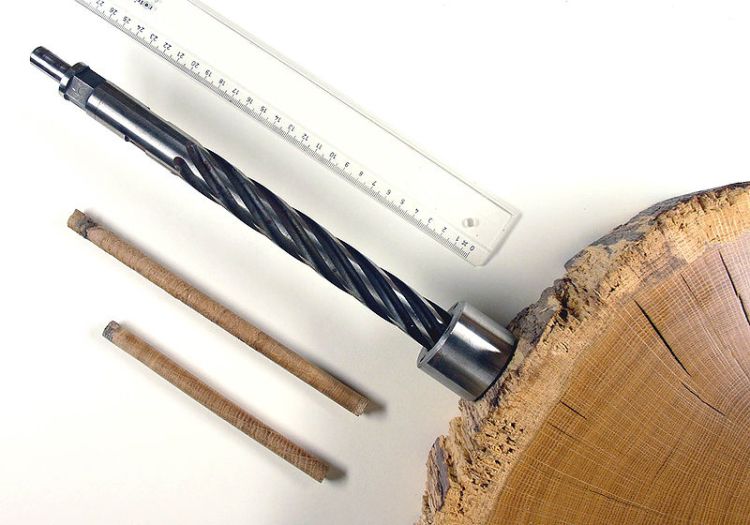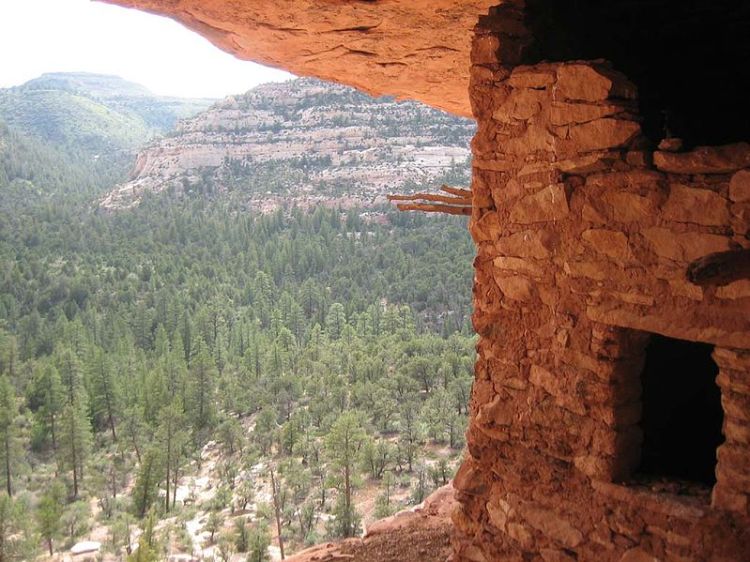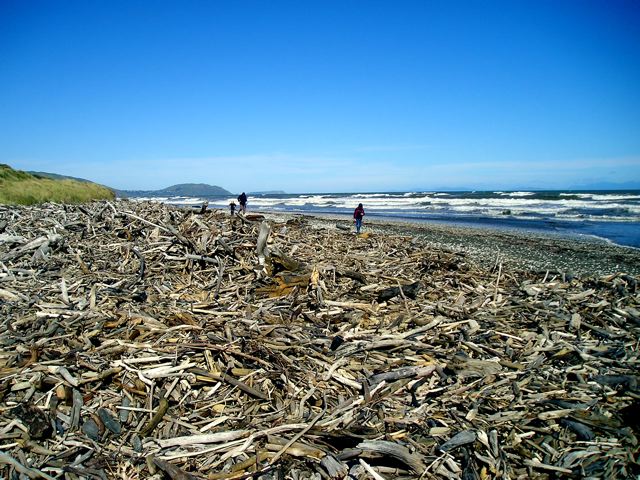By Audrey Cross

A tree corer used to drill into a trunk, and two tree cores. Rings are counted from these cores and used to date events or reconstruct climate change. Wikimedia Commons.
In dendrochronology, most analyses rely on a number of underlying assumptions. For wood that was used by humans, a tree might have been used immediately after it died, and it could be found at a site nearby where the tree had lived. However, humans could obtain wood in different ways; it could be found, as with driftwood; recycled, as with beams in houses; or transported, as with boats.
The study of driftwood proposes an interesting twist to dendrochronological analysis because the amount of time that wood can spend in transport can vary greatly. While wood will only float for about ten months (Eggertsson & Laeyendecker, 1995), the transport of ice from one coast to another can include time on beaches and/or time caught in or amongst sea ice. Keep in mind that both beaches and sea ice are not static in their presence or extent, so there are no uniform conditions through time for driftwood movement. This relates to the complicating factor of changes in ocean currents though time, which can be caused by a variety of environmental changes. This can be useful, however, when a study is seeking to identify changes in ocean currents by figuring out the origin locations of driftwood species, as in the Arctic (Eggertsson & Laeyendecker, 1995; Eggertsson, 1994). For a paper about the Mackenzie River delta, located in Canada along the Arctic Ocean by the Yukon & Northwest Territories, the wood found there reflected long-distance transport from Greenland, Russia, Alaska, and other parts of Canada. Keeping in mind the influence of sea ice on currents, note the more recent ocean currents of the Arctic Ocean are shown in Figure 1 (Eggertsson, 1994). For archaeological analyses, it is not uncommon for people to use driftwood (in art, tools, construction, fires, etc.), as it could be a primary source of source of available wood—in some situations, the only source, as on some islands and in arid climates.
Other methods of wood transport exist, too. In the 11th century, the Chaco Canyon in New Mexico was the site of a thriving culture of Anasazi people, with complex infrastructure for agriculture and trade (English, Betancourt, Dean, & Quade, 2001; Windes & Ford, 1996). Monumental architecture featured primarily large timbers and mud, though the Chaco Canyon is now a treeless area. Seventy-five to one hundred kilometers away, though, are mountains that have trees, and it is believed they transported the wood that long distance. Each mountain has dust, water, and bedrock with a distinct ratio of Strontium-87 to Strontium-86; by comparing the 87Sr/86Sr ratios found in the wood to that of each mountain, they can prove where the tree grew (English et al., 2001). One theory is that this wood was transported down waterways during times of flood (Adams & Hedberg, 2002).
In addition to long-distance transport of wood, these large beams in the southwestern United States, which were transported perhaps 1200 years ago, have been reused since this initial transport (English et al., 2001; Windes & Ford, 1996). Large timbers were used as supports in the construction of massive buildings, and when old buildings were taken down or needed to be repaired, logs like this were used in new buildings (Windes & Ford, 1996). These logs are from regions where growth is slow, meaning the logs of sizeable volume would have many rings of growth, making the Southwestern specimens great for dendrochronology (Adams & Hedberg, 2002).

Anasazi ruin, with logs sticking out. Such structures can be dated using tree rings. Wikimedia Commons.
In any instance where boats or parts of boats are found, there are also inherently issues of origin of the wood. These kinds of study are useful not just for tree-ring counting, but also for analyzing changes in trade, currents, and valuation of different types of wood. Tree-ring studies have linked artifacts from one area to sites that are far away; this is because rainfall and conditions differ from one area to the next, so there would be different relative tree-wing width in these two areas. Applying this to the archaeology side of things, it’s important to note that Vikings in Iceland didn’t have much access to wood, and so they got it from elsewhere. For example, oak wood used in one of the Viking ships found in an excavation is speculated to be from Dublin, Ireland (Bonde, 1998). Figuring out the sources of wood on a longer time scale requires a lot of extrapolation to understand past climate conditions. However, paleoecology and other studies of the past can use a variety of proxies to inform this extrapolation.
Works Cited:
Adams, E. C., & Hedberg, C. (2002). Driftwood Use at Homol’ovi and Implications for Interpreting the Archæological Record. Kiva, 7(4), 363–384. Retrieved from http://www.jstor.org.prxy4.ursus.maine.edu/stable/pdfplus/30246405.pdf?&acceptTC=true&jpdConfirm=true
Bonde, N. (1998). Found in Denmark, but Where Do They Come From? Archaeology Ireland, 12(3), 24–29.
Eggertsson, O. (1994). Mackenzie River Driftwood– A Dendrochronological Study. Arctic, 47(2), 128–136. Retrieved from http://www.jstor.org.prxy4.ursus.maine.edu/stable/pdfplus/40511551.pdf?&acceptTC=true&jpdConfirm=true
Eggertsson, O., & Laeyendecker, D. (1995). A Dendrochronological Study of the Origin of Driftwood in Frobisher Bay, Baffin Island, N.W.T., Canada. Arctic and Alpine Research, 27(2), 180–186. doi:10.2307/1551900
English, N. B., Betancourt, J. L., Dean, J. S., & Quade, J. (2001). Strontium Isotopes Reveal Distant Sources of Architectural Timber in Chaco Canyon, New Mexico. Proceedings of the National Academy of Sciences of the United States of America, 98(21), 11891–11896. Retrieved from http://www.jstor.org.prxy4.ursus.maine.edu/stable/pdfplus/3056819.pdf?acceptTC=true&jpdConfirm=true
Windes, T. C., & Ford, D. (1996). The Chaco Wood Project: The Chronometric Reappraisal of Pueblo Bonito. American Antiquity, 61(2), 295–310. doi:10.2307/282427

It can be dangerous to make assumptions in science, such as assuming that a log from a house or boat must have come from close-by. Perhaps a given area used to be a grassland and the residents of the town had to import their wood to make houses, but since that time the land has become forested; anyone studying the area may assume the houses were built from the surrounding trees. Good article outlining a different side of a common paleoecological practice, I never knew that we could determine what part of the world wood came from to build boats and houses!